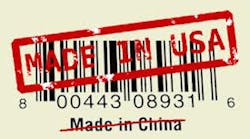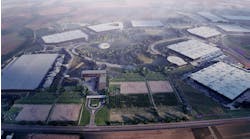Reshoring Best Practices for Manufacturers
Relocating manufacturing operations back to the U.S. from Asia, European and South American countries is a growing trend. There is a steady increase in the number of companies considering reshoring their manufacturing operations to the U.S. Before undertaking a resoring project, manufacturers need to conduct a comprehensive cost-analysis of overall costs and benefits of relocating.
The reshoring trend includes the relocation of manufacturing back to the U.S., and new greenfield investment in plants that might have gone overseas. O’Neal, an integrated design and construction firm that specializes in project delivery, recently helped a European-based chemical processing company define the cost, schedule and overall project scope for a manufacturing investment in the U.S.
See Also: Is Reshoring Really Working?
O’Neal is also in the process of helping other companies bring certain manufacturing and production lines from Asia, Europe and other areas to the U.S. The owners of the companies involved in these projects originally considered overseas locations but are now involved with projects in North Carolina, South Carolina, Georgia, Louisiana, and Texas.
By setting up operations in the U.S., companies are experiencing certain advantages such as reduced energy and transportation costs. The recent drop in natural gas prices in the U.S. has created cost efficiencies and advantages for manufacturers. Rising oil prices have resulted in increased shipping costs for manufacturers bringing goods into the U.S.
Another factor in making the decision to reshore includes currency fluctuations. Combined with the weak U.S. dollar, American and overseas manufacturing companies can now get more return on their investment in the U.S. for expansion and production. Overall, economists predict a stable long-term economic outlook in the U.S., particularly when compared to many other countries.
Labor issues is an important part of the cost equation as rising labor costs are challenging profitability for manufacturing companies. According to a recent PricewaterhouseCoopers LLP report, manufacturing labor costs in China have risen by more than 80% from 2008-2011. The study also indicates that Chinese labor costs will continue to rise at a similar rate for at least the next four years. Concurrently, the increasing flexibility and productivity of the American worker, along with the increase in advanced manufacturing techniques that makes production less labor intensive, is also another part of the story.
Several manufacturers recently have been faced with inconsistent and low quality products coming from certain areas in Asia. Loss due to utilizing a cheaper labor pool of employees who are unable to provide the quality expected of customers is an important factor for consideration. Concerns over quality and protection of intellectual property are also part of the equation.
Other considerations when deciding to reshore depends on customer location. Keeping production local to domestic markets and protecting the supply chain makes financial and logistical sense for many manufacturers. By manufacturing goods closer to where they are sold, companies can be flexible and responsive to changes in market demand, enjoy lower distribution costs and ensure quality standards are met and intellectual property remains safe.
Analyze All Factors Before Decision
Evaluating the overall benefits and consequences of staying in the current location versus reshoring is crucial to success and avoiding unexpected events and delays during relocation. Obviously, an important consideration is the cost associated with moving operations back to the U.S.
However, the costs related to the downtime required to facilitate a move to the U.S. and all of the possible “hidden” costs must also be part of the overall equation for a company considering reshoring. The total cost of moving production overseas is hefty, taking into consideration factors like engineering, pre-planning, and cost to package, transport and re-install production equipment and process lines in the U.S. Additionally, Duties, customs and other fees associated with exporting a company’s product should be compared to that of distributing the product in a new location. Other factors include language and cultural barriers as well as the cost savings or advantage of occupying the new location relative to other facilities when product design, model changes or communication is important.
However, reshoring presents significant challenges in some industries. Manufacturers face hurdles from new healthcare legislation, stringent EPA and emissions regulation guidelines and corporate tax rates in flux. A recent MIT survey reported that U.S. companies named corporate tax reductions, providing tax credits and R&D incentives as the top three government actions that will accelerate the reshoring process.
Manufacturers need to take a broad look at their business models and consider the big picture when thinking about reshoring. While improving one or two aspects of the business that are causing concern may save considerable amounts of money, the savings could be lost in other areas that are affected by the change.
The vetting process for companies considering reshoring also includes an examination of post-move factors, such as regulation, logistics and transportation. If environmental impact is a concern, companies should consider whether the environmental regulation (or proposed regulation) is more intense at the proposed location or the existing location of manufacturing, and any financial impact incurred as a result. A comparison of the transportation and shipping infrastructure, including the ease and economy of utilizing it, should also be evaluated, particularly if a company manufacturers and ships products.
Manufacturing companies cannot afford to ignore the reshoring movement. For certain manufacturing companies, reshoring to the U.S. can be a sound financial decision. But before spending valuable dollars to relocate production facilities, conducting a comprehensive cost-analysis of overall benefits, as well as company-focused advantages and disadvantages for every aspect of production, is a crucial part of the process.
Brian Gallagher is Director of Marketing and Dan Mollohan leads O’Neal’s Inc. Manufacturing Relocation Operations. For more than 38 years, O’Neal has been delivering capital projects in the automotive, pharmaceutical/biotech, process chemical, manufacturing, energy and pulp and paper markets worldwide.




